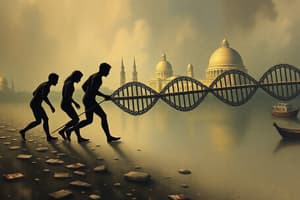Podcast
Questions and Answers
Match the following characteristics of life with their descriptions:
Match the following characteristics of life with their descriptions:
Homeostasis = Ability to maintain internal stability despite external changes Metabolism = Physical and chemical processes within cells to sustain life Growth = Increase in size or number of cells Reproduction = Production of offspring
Match the following examples with the corresponding homeostatic process:
Match the following examples with the corresponding homeostatic process:
Regulating blood sugar levels through insulin production = Homeostasis Maintaining acid-base balance with kidney function = Homeostasis Temperature regulation through sweating or shivering = Homeostasis Breaking down molecules to release energy = Metabolism
Match the following terms with their definitions:
Match the following terms with their definitions:
Catabolic processes = Break down molecules to release energy Anabolic processes = Synthesize complex organic compounds using released energy Nutrients breakdown = Conversion into simpler forms for cellular reactions Cellular reactions = Usage of transported nutrients for cell functions
Match the following biological processes with their descriptions:
Match the following biological processes with their descriptions:
Signup and view all the answers
Match the following growth patterns with their corresponding organisms:
Match the following growth patterns with their corresponding organisms:
Signup and view all the answers
Match the following examples of responses to stimuli with their descriptions:
Match the following examples of responses to stimuli with their descriptions:
Signup and view all the answers
Match the following reproduction methods with their characteristics:
Match the following reproduction methods with their characteristics:
Signup and view all the answers
Study Notes
Biology is the scientific study of life and living organisms, encompassing their physical and chemical properties, structure, growth, behavior, and reproduction. Living organisms, also known as biological entities or organisms, are defined by several characteristics that distinguish them from non-living things such as lifeless matter. These traits, collectively referred to as the "properties of life," include homeostasis, metabolism, growth, response to stimuli, and reproduction. Let's explore each of these characteristics in more detail:
1. Homeostasis
Homeostasis refers to the ability of a living organism to maintain its internal environment relatively stable despite changes occurring around it. This stability is crucial for proper functioning, survival, and development. Examples of homeostatic processes include temperature regulation through sweating or shivering, regulating blood sugar levels through insulin production, and maintaining acid-base balance with kidney function.
2. Metabolism
Metabolism describes all the physical and chemical processes that occur within living cells to sustain life. It involves both catabolic processes, which break down molecules to release energy, and anabolic processes, where complex organic compounds are synthesized using energy released during catabolism. Nutrients are broken down into simpler forms that can be transported and used in cellular reactions. Metabolic pathways involve many intermediates and enzymes, allowing for precise control over energy generation and storage.
3. Growth
Growth is essential for the continuance of any species. All living things grow, either increasing in size or complexity throughout their lives. Microorganisms like bacteria and fungi often grow rapidly under favorable conditions, while plants may grow slowly over years. Animals typically have a limited period of rapid growth during their early stages, followed by steady maintenance until maturity. In humans, growth begins inside their mother's body and continues until they reach young adulthood.
4. Response to Stimuli
Living beings respond to external signals, called stimuli, leading to specific actions. Responses may range from simple reflexes, such as withdrawing your hand when touching a hot surface, to more complex behaviors, including learning from experiences and adaptive strategies. Sensory receptors detect environmental changes, transmitting information via nerve impulses to the brain for interpretation and appropriate responses.
5. Reproduction
The process of reproduction ensures the continuity of life by passing genetic material from one generation to another. Living organisms reproduce sexually or asexually, depending on whether new offspring inherit genetic variation from multiple parents (sexual) or just one (asexual). Sexual reproduction often involves meiosis, reducing chromosomes from 46 to 23, followed by fertilization where two gametes combine to form a zygote. Asexual reproduction methods include budding, fragmentation, and binary fission, among others.
Understanding these essential properties of life is crucial for advancing our knowledge of biology and applying it to various fields, such as medicine, agriculture, and environmental conservation. It also helps us appreciate the complex interconnectedness of living systems within our world.
Studying That Suits You
Use AI to generate personalized quizzes and flashcards to suit your learning preferences.
Description
Delve into the fundamental characteristics that distinguish living organisms from non-living things, including homeostasis, metabolism, growth, response to stimuli, and reproduction. Learn how these properties are essential for the survival, development, and continuity of life.




